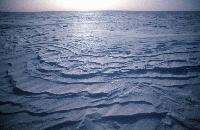New research sheds light on Earth's coldest temperatures

(PhysOrg.com) -- Results from the first detailed analysis of the lowest ever temperature recorded on the Earth's surface can explain why it got so cold and how cold it could possibly get.
During the Antarctic winter of 1983 (July) temperatures plunged to a record-breaking -89.2°C at the Russian Vostok research station — more than 30°C lower than the average winter temperature. Until this study scientists did not understand why or how the temperature on the vast East Antarctic plateau could hit such an extreme low.
Scientists at British Antarctic Survey (BAS) and the Arctic and Antarctic Research Institute (AARI) in Russia found that for a period of 10 days the air flow that is normally fed from the Southern Ocean on to the high Antarctic plateau almost stopped.
A flow of cold air circling Vostok was preventing the mixing of this warmer air from lower latitudes, isolating the station and causing near optimum cooling conditions. Adding to this was the absence of cloud cover and the layer of tiny particles of ice suspended in the air (known as diamond dust) allowing more heat from the ice surface to be lost to space.
The study was able to successfully simulate the rapid loss of heat over the 10 day period, which will aid the development of climate models used to predict the future evolution of the Antarctic climate system.
Lead author Professor John Turner at BAS says,
“The majority of Antarctica has not yet warmed to the same extent as the Arctic, but over the next century we expect to see this situation change as the effects of greenhouse gas emissions have an impact. Distinguishing between natural variability and human induced changes to the Earth’s atmospheric climate is at the heart of our research and we wanted to understand why this ‘normal’ weather system was thrown out of balance so severely. Our findings indicate that this was a natural event, but this is an important reminder of just how extreme Earth’s natural events can be and that we must always consider the potential for such anomalies to occur. The East Antarctic plateau is remote from the ocean and extremely cold, and we believe that Vostok, at an altitude of 3,488m could get even colder, possibly reaching −96°C if an extreme isolation period such as this occurred over a longer period of time. Temperatures may even drop to −100°C at the higher Dome A — the summit of the East Antarctic Ice Cap. By appreciating that such possibilities can occur and in turn striving to understand the processes that cause them we are better equipped to make predictions for how the planet might react to future changes in polar atmospheric climate.”
Provided by British Antarctic Survey

















